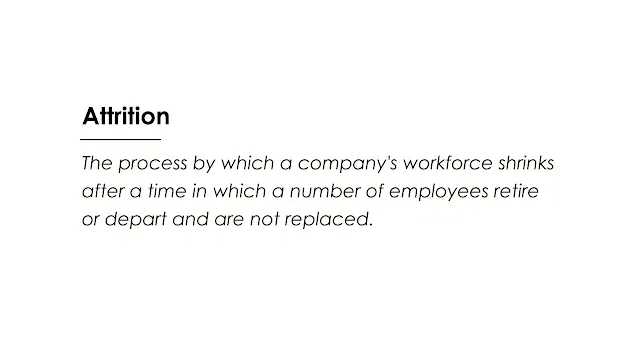 |
| Image: Moneybestpal.com |
Attrition is the process by which a company's workforce shrinks after a time in which a number of employees retire or depart and are not replaced. Attrition-related staff reductions are frequently referred to as hiring freezes and are considered to be less disruptive than layoffs for reducing payroll. A company's performance, productivity, morale, and level of customer happiness can all suffer from attrition, though.
Industry, geographic region, and time period all affect attrition rates. The U.S. Bureau of Labor Statistics reports that, between 2011 and 2020, voluntary attrition accounted for an average of 54.6 percent of all separations. This percentage increased to 67 percent in 2021, the greatest level in the previous ten years, nonetheless. The "Great Attrition" or "Great Resignation" phenomenon refers to the fact that many more people are leaving their jobs than in the past for reasons other than disappointment, sadness, burnout, or a desire to pursue a different line of work.
Attrition has a greater impact on some industries than others. For instance, attrition rates in the healthcare and technology industries are now 3.6% and 4.5% higher than they were the year before. These industries deal with high-stress levels and stiff rivalry for talent, as well as significant demand for their services. Retail, hospitality, education, and manufacturing are further sectors with high turnover rates.
Regional differences in attrition rates can be attributed to elements including prevailing economic conditions, labor market dynamics, cultural norms, and pandemic reactions. In the Americas and Europe, Middle East, and Africa (EMEA) regions, for example, staff attrition rates declined somewhat in 2022, but they stayed unchanged in the Asia Pacific, according to a survey of professional services businesses globally. The attrition rates in these areas, which ranged from 13 percent to 14 percent between 2015 and 2022, were still among the highest.
Organizations must comprehend the underlying reasons for employee turnover and put measures in place to both retain and recruit talent if they are to successfully manage the problem of attrition. Lack of career development opportunities, low engagement and recognition, poor work-life balance, insufficient pay and benefits, misaligned expectations and values, and inefficient management and leadership are a few of the frequent causes of turnover. To counter these factors, organizations can adopt practices such as:
- Conducting routine exit interviews and staff surveys to determine opportunities for growth and satisfaction.
- Supplying clear career routes and educational opportunities so that workers can develop and advance.
- Fostering a feedback and praise culture that encourages employee motivation and loyalty.
- Provide flexible working conditions and health programs that promote employee autonomy and well-being.
- Matching perks and pay to market norms and employee preferences.
- Achieving congruence between employee aims and interests and the organization's vision, purpose, and values.
- Creating capable managers and leaders who can encourage, support, and motivate their teams.
Employing these strategies can help businesses attract new talent in a competitive market by lowering attrition rates and boosting their employer brands. Organizations can also save money on hiring expenditures, increase productivity, strengthen customer connections, and perform better overall by keeping their current workforce.
